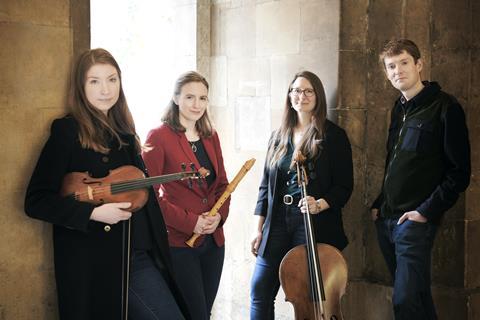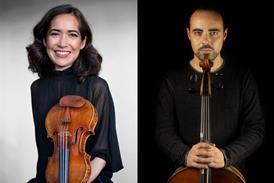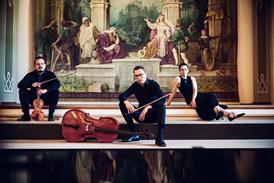Ahead of a concert at Music at Paxton, Mary-Jannet Leith of period group Ensemble Hesperi, explores the vibrant musical world of London’s Strand at the turn of the 18th century.

Discover more Featured Stories like this in The Strad Playing Hub.
By 1700, London was one of Europe’s largest musical hubs, attracting a huge number of immigrant musicians who seized the opportunity to earn a steady income in the city’s burgeoning musical scene. Home to countless music shops and entertainment venues, the Strand was at the epicentre of this explosion in London’s musical life. Our programme, Handel in the Strand, captures the spirit of music-making across the theatres, taverns and homes along this bustling thoroughfare of commerce.
Halfway along the Strand, just at the end of Catherine Street, was the ’Harp and Hoboy’, the premises of John Walsh, one of the most prosperous music publishers of the 18th century. Walsh is notorious today for pirating musical works and re-printing them with his own title pages, including those by leading composers of his day. In the 1730s, he published several of Handel’s instrumental works, including his Op. 2 trio sonatas, with a bogus title page of the Amsterdam publisher Jeanne Roger, a trick no doubt designed to give his publications an air of grandeur and increase his own profit. Many of the Op. 2 sonatas were actually composed much earlier in Handel’s life, including the exquisite HWV 386, for which a manuscript survives from Handel’s period as house composer to James Brydges, 1st Duke of Chandos, at his grand estate, Cannons.
Heading to the western end of the Strand, Handel himself was often to be found at the Kings Theatre Royal, Haymarket, leading the band in his Italian operas and English oratorios. The names of Handel’s chosen musicians have been largely lost to the mists of time, but Giuseppe Sammartini (also known as San Martini) is often scrawled on Handel’s opera autographs as a soloist on the ‘hautboy’ or oboe. Sadly forgotten today, Sammartini’s music was as popular in his day as that of Corelli, and he was celebrated and envied as a virtuoso. The music historian John Hawkins wrote: ’As a performer on the hautboy, Martini was undoubtedly the greatest that the world had ever known. Before his time the tone of the instrument was rank, and in, the hands of the ablest proficient, harsh and grating to the ear; but by great study and application, and by some peculiar management of the reed he contrived to produce such a tone, as approached the nearest to that of the human voice of any we know of.’ Sammartini’s fiery Sonata VI, written in 1727 for two wind instruments, is certainly a virtuosic workout for the solo lines.
One of Handel’s choice singers at the Theatre Royal was mezzo-soprano and keyboard player Elisabetta de Gambarini, who made her vocal debut in Handel’s Occasional Oratorio in 1746. The daughter of an immigrant Italian noble family, Elisabetta also gave regular benefit concerts for London audiences on the harpsichord. Her Op. 1 collection, Six Sets of Lessons for the Harpsichord, was the first collection of keyboard works to be published by a woman in the British Isles. Like most marginalised composers of the time, Gambarini’s works were self-published, yet her Op. 2 collection, Lessons for the Harpsichord Intermix’d with Italian and English songs, was funded by an impressive array of aristocratic subscribers, and dedicated to Frederick, Prince of Wales. It features a selection of short character pieces and dances, including a ‘Cariglion’ in D minor which imitates the peals of bells through flashy arpeggios and charming galant figures. In her early 30s, Gambarini married at the church of St Martin-in-the Fields, but died less than a year later at her home on Castle Court, Strand, her career cut cruelly short.
At the far eastern end of the Strand lies the boundary dividing Westminster from the City of London. Here lies Temple Church, which to this day serves the legal colleges of the Inner and Middle Temples. In the 1680s, following the refurbishment of the church by Christopher Wren, a dispute arose as to which of two leading organ builders of the day should furnish the church with a new instrument. The Benchers of Middle Temple had a strong preference for an organ by Bernhard Smith, but those of Inner Temple favoured the challenger, Renatus Harris. In a matter of months, the two men erected two organs at opposite ends of the church, inviting celebrated players of the day to showcase their craftsmanship in ever-more virtuosic performances. The winning organ in this ’Battle of the Organs’ was showcased by Henry Purcell and John Blow. Today we know Purcell and Blow best for their operatic and sacred music, but both composers also produced small-scale instrumental music that perfectly captures the cosmopolitan musical tastes of late seventeenth-century England. Blow’s only trio sonata in A major is full of lyricism and operatic flair, and Purcell’s Sonata in B minor from Ten Sonatas in Four Parts showcases playful yet elegant counterpoint alongside Italian vigour. Unknown upon Purcell’s death, this collection was published posthumously by his widow, Frances, who arranged for his music to be printed and sold by the publisher Henry Playford at Temple Change.
In 1741, the Scottish composer, cellist and all-round entrepreneur James Oswald left Edinburgh for London, where he set up a music shop on the pavement of St Martin-in-the-Fields, moments away from the west end of the Strand. Oswald, known in his time as the ’Scots Orpheus’, was one of many Scottish musicians to take advantage of the growing craze for Scottish music among London’s elites. Oswald certainly used his Scottish musical heritage to establish a niche for himself in London, often performing ‘A Scotch tune’ entr’acte at the Drury Lane theatre to advertise his recently published collections of Scottish music. Oswald soon secured the illustrious patronage of Frederick, Prince of Wales, and his wife Princess Augusta, whose townhouse lay moments away from the Strand in modern-day Leicester Square. After Frederick’s death, Augusta herself expanded an already substantial botanical collection at Kew Palace, laying the foundations for the present-day Kew Gardens. Oswald no doubt enjoyed the exotic plants at Kew when he visited to teach Augusta and her children, perhaps inspiring his extraordinary composition of 96 floral miniatures in 1755. Oswald’s Airs for the Seasons showcase Oswald’s genius for melody, and transport the listener to his native Scotland with a Scotch snap rhythm or a reel disguised as an Allegro!
Above all, the world of the Strand was one of London’s busiest centres of commerce, and by the middle of the eighteenth century, music itself was big business. Performers, printers and patrons eagerly competed to keep up with musical fashion, often chasing the latest styles from continental Europe. Every note played or sung in the Theatre Royal, every page printed in Walsh and Oswald’s music shops, was part of a dynamic music industry whose beating heart lay in the streets of 18th-century London.
Ensemble Hesperi will perform works by Handel, Playford, Purcell, Telemann, Osward, Blow, Sammartini, Elisabetta de Gambarini and Robert Bremner at Music at Paxton, 7:30pm 23 July 2024. Find out more here.
Read: Scottish folk baroque fusion: When worlds collide
Listen: The Strad Podcast Episode #58: Bjarte Eike on the Playhouse Sessions
Read more Featured Stories like this in The Strad Playing Hub
The number one source for playing and teaching books, guides, CDs, calendars and back issues of the magazine.
In The Best of Technique you’ll discover the top playing tips of the world’s leading string players and teachers. It’s packed full of exercises for students, plus examples from the standard repertoire to show you how to integrate the technique into your playing.
The Strad’s Masterclass series brings together the finest string players with some of the greatest string works ever written. Always one of our most popular sections, Masterclass has been an invaluable aid to aspiring soloists, chamber musicians and string teachers since the 1990s.
American collector David L. Fulton amassed one of the 20th century’s finest collections of stringed instruments. This year’s calendar pays tribute to some of these priceless treasures, including Yehudi Menuhin’s celebrated ‘Lord Wilton’ Guarneri, the Carlo Bergonzi once played by Fritz Kreisler, and four instruments by Antonio Stradivari.






































No comments yet